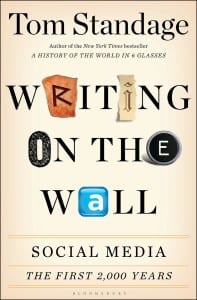 What if social media – an idea most of us associate with the past decade – is actually something we’ve been using for 2,000 years? And what if mass media – an industry we think of as seriously challenged by ‘new’ media innovations – is actually the disruptive agent running counter to a much longer trend of social human-to-human communication?
What if social media – an idea most of us associate with the past decade – is actually something we’ve been using for 2,000 years? And what if mass media – an industry we think of as seriously challenged by ‘new’ media innovations – is actually the disruptive agent running counter to a much longer trend of social human-to-human communication?
These are two of the ideas behind Tom Standage’s book Writing On The Wall, which provides an insightful connection between the historical past to the questions of today, with some interesting implications for tomorrow.
I asked Tom to speak at a meeting of a group that I chair for the World Economic Forum tasked with exploring and sharing ideas on the future of media. It’s hard to look at tomorrow without at least some reference to yesterday, I reasoned, and Tom’s book was the perfect primer.
No spoilers here, but the gist of Writing On The Wall is that humans are neurologically wired for sharing. And as soon as literacy rates got high enough, and the costs of distributing information got cheap enough (during the early Roman republic), Standage argues that forms of communication we might recognize as social media began to emerge.
From then on, people exchanged ideas through social connections to create a distributed discussion. The channels varied and evolved – copied letters, coffee house pamphlets, wax tablets, and papyrus are among those vividly described – but ‘media’ was essentially social in nature: shareable, largely egalitarian and often provocative.
Then the mass-circulation of newspapers began to appear in London and New York. Powered by steam presses in the early 19th century, newspapers (and later radio and TV) could reach millions, and ‘mass media’ became the norm. With mass media, opinion could be synchronized on a truly huge scale, making possible ideas like the modern nation-state, national brands, and massive entertainment properties in film and broadcast.
And then: the internet. It didn’t kill mass media, but it reintroduced social media through platforms like Facebook and Twitter and, again (or still), people are sharing ideas socially and creating discussions but now on a global scale. Now we live a world hyper-connected through both social and mass media.
So what does this tell us about the future?
Our group discussion and conclusions were largely positive, although cautionary: Innovation will be accelerated and more widely distributed (good, for example, in medicine – not so good, for example, within criminal enterprises). Also, opinion will be galvanized and leveraged more powerfully (reduce prejudice, good; spread hate, bad) while self-expression and the definition of community will continue to evolve rapidly and possibly radically (with purely subjective risks and benefits, depending on your perspective).
Personally, I can see a bright and wonderful (and occasionally strange and scary) new world, powered by individuals connected socially on a global scale, and dreaming up ideas magnified far beyond any scope we can imagine.
Then again, the Romans would have had a hard time imagining our little world today.


